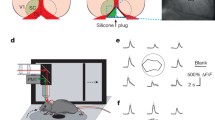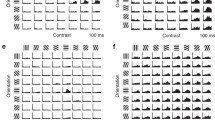Abstract
The sensitivity of neurons in field 17 of the visual cortex in cats to cross-shaped, Y-shaped, and star-shaped figures flashing in the receptive field was studied. About 40% of the neurons studied (114 of 289) were found to generate large responses (with an average response factor of 3.06±0.32) to one of the figures flashing in the center of the receptive field, as compared with the responses produced to a single bar in the optimal orientation. Most of these neurons (72%) were selectively sensitive to the shape and orientation of figures; the remainder demonstrated some degree of tuning invariance to these properties. The latent periods of responses to figures were usually shorter than those of responses to bars. Tuning parameters for bars and figures were generally related: neurons with acute orientational tuning to a bar were usually highly selective to both the configuration and the orientation people figures. Separate or combined stimulation with crosses in the center and near periphery of the receptive fields demonstrated summation, antagonism, or the lack of any interaction between these zones in producing sensitivity to crosses. Local blockade of intracortical GABAergic inhibition by microiontophoretic application of bicuculline showed that in one third of the neurons studied, sensitivity to figures was generated or enhanced by inhibition in normal conditions, while one third of cells showed suppression by inhibition, and sensitivity in the remainder was independent of inhibition. These data show that reconsideration of existing concepts of the role of field 17 in selecting only first-order shape features of images (i.e., the orientations of single lines) is needed, since almost half the neurons in the cat primary visual cortex can efficiently detect second-order features (angles and line intersections).
Similar content being viewed by others
References
G. M. Zenkin and A. P. Petrov, “A system for image analysis and the recognition of objects on complex backgrounds,”Biofizika,12, 493–501 (1967).
N. A. Lazareva, I. A. Shevelev, R. V. Novikova, A. S. Tikhomirova, and G. A. Sharaev, “Double orientational tuning of neurons in the primary visual cortex of the cat at different levels of consciousness,”Neirofiziologiya,24, 260–269 (1992).
N. A. Lazareva, I. A. Shevelev, U. Eysel, and G. A. Garaev, “Bicuculline and orientational tuning of neurons in the visual cortex,”Neirofiziologiya,27, 54–63 (1995).
N. A. Lazareva, I. A. Sheveleva, R. V. Novikova, A. S. Tikhomirov, and G. A. Sharaev, “The selective sensitivity of striate neurons in the cat to cross-like and angular figures of different orientations,”Neirofiziologiya,27, 403–412 (1995).
N. A. Lazareva, I. A. Shevelev, G. A. Sharaev, R. V. Novikova, and A. S. Tikhomirov, “The sensitivity of neurons in the cat visual cortex to cross-like figures in conditions of stimulation of the center or periphery of the receptive field,”Zh. Vyssh. Nerv.Deyat.,48, 485–495 (1998).
I. A. Shevelev,Visual Cortex Neurons: Adaptivity and Dynamics of Receptive Fields [in Russian], Nauka, Moscow (1984).
I. A. Shevelev, U. T. Eysel, K.-U. Irmann, and G. A. Sharaev, “Responses of visual cortex neurons to cross-like figures in conditions of local blockade of inhibition,”Dokl. Ross.Akad. Nauk,363, 137–140 (1998).
I. A. Shevelev, U. T. Eysel, K. U. Irmann, and G. A. Sharaev, “Tuning of striate neurons to cross-like figures in conditions of local blockade of intracortical inhibition,”Zh. Vyssh. Nerv. Deyat.,49, 271–278 (1999).
I. A. Shevelev, N. A. Lazareva, R. V. Novikova, A. S. Tikhomirov, and G. A. Sharaev, “Tuning of cat visual cortex neurons to the extraction of cross-like figures,”Neirofiziologiya,1, 362–265 (1993).
I. A. Shevelev, G. A. Sharaev, N. A. Lazareva R. V. Novikova, and A. S. Tikhomirov, “Double orientational tuning of cat visual cortex neurons,”Neirofiziologiya,15, 459–466 (1983).
B. D. Burns and R. Pritchard, “Geometrical illusions and the response of neurones in the cat's visual cortex to angle patterns,”J. Physiol. (London),213, 599–616 (1971).
R. H. S. Carpenter and C. Blakemore, “Interactions between orientations in human vision,”Exp. Brain Res.,18, 287–303 (1973).
S. Chen and D. M. Levi, “Angle judgment. Is the whole the sum of its parts?,”Vision Res.,36, 1721–1735 (1996).
J. Cudeiro and A. M. Sillito, “Spatial frequency tuning of orientation-discontinuity-sensitive corticofugal feedback to the cat lateral geniculate nucleus,”J. Physiol. (London),490, 481–492 (1996).
G. C. DeAngelis, J. G. Robson, I. Ohzawa, and R. D. Freeman, “Organization of suppression in receptive fields of neurons in cat visual cortex,”J. Neurophysiol. 68, 144–163 (1992).
R. J. Douglas and K. A. Martin, “A functional microcircuit for cat visual cortex,”J. Physiol. (London),440, 735–769 (1991).
E. S. Eriksson, “A field theory of visual illusions,”Brit. J. Psychol.,61, 451–466 (1970).
U. T. Eysel, “Lateral inhibitory interactions in area 17 and 18 of the cat visual cortex,”Progr. Brain Res.,90, 407–422 (1992).
U. T. Eysel, J. M. Crook, and H. F. Machemer, “GABA-induced remote inactivation reveals cross-orientation inhibition in the cat striate cortex,”Exp. Brain Res. 80, 626–630 (1990).
U. T. Eysel and I. A. Shevelev, “Time-slice analysis of inhibition in cat striate cortex neurones,”NeuroReport,5, 2033–2036 (1994).
I. Fujita, K. Tanaka, M. Ito, and K. Cheng, “Columns for visual features of objects in monkey inferotemporal cortex,”Nature,360, 343–346 (1992).
M. Georgeson, “Human vision combines oriented filters to compute edges,”Proc. Roy. Soc. Lond.,B249, 235–245 (1992).
C. D. Gilbert and T. N. Wiesel, “The influence of contextual stimuli on the orientational selectivity of cells in primary visual cortex of the cat,”Vision Res.,30, 1689–1701 (1990).
M. S. Gizzi, E. Katz, R. A. Schumer, and J. A. Movshon, “Selectivity for orientation and direction of motion of single neurons in cat striate and extrastriate visual cortex,”J. Neurophysiol.,63, 1529–1543 (1990).
R. Gray and S. J. Hamstra, “Evidence for a neuronal mechanism that encodes angles,”Vision Res.,36, 323–330 (1996).
K. L. Grieve and A. M. Sillito, “Length summation in layer VI cells of cat visual cortex and hypercomplex cell inhibitory end zones in the anesthetized cat,”J. Physiol. (London),416, 21–37 (1989).
P. Hammond and D. P. Andrews, “Orientation tuning of cells in areas 17 and 18 of the cat's visual cortex,”Exp. Brain Res.,31, 341–351 (1978).
D. W. Heeley and H. H. Buchanan-Smith, “Recognition of stimulus orientation,”Vision Res.,30, 1429–1437 (1990).
P. Heggelund and K. Albus, “Orientation selectivity of single cells of striate cortex of cat: the shape of orientation tuning curves,”Vision Res.,18, 1067–1071 (1978).
G. H. Henry, “Receptive field classes of cells in the striate cortex of the cat,”Brain Res.,133, 1–28 (1977).
G. H. Henry, B. Dreher, and P. O. Bishop, “Orientation specificity of cells in cat striate cortex,”J. Neurophysiol.,37, 1394–1409 (1974).
D. H. Hubel and T. N. Wiesel, “Receptive fields, binocular interaction and functional architecture in the cat's visual cortex,”J. Physiol. (London),160, 106–154 (1962).
D. H. Hubel and T. N. Wiesel, “Receptive fields and functional architecture in two nonstriate visual areas (18 and 19) of the cat,”J. Neurophysiol.,28, 229–289 (1965).
E. Kobatake and K. Tanaka, “Neuronal selectivities to complex objects features in the ventral visual pathway of the macaque cerebral cortex,”J. Neurophysiol.,71, 856–867 (1994).
L. Lagae, H. Maes, S. Raiguel, D. K. Xiao, and G. A. Orban, “Responses of macaque STS neurons to optic flow components: a comparison of areas MT and mST,”J. Neurophysiol.,71, 1597–1626 (1994).
J. B. Levitt and J. S. Lund, “Contrast dependence of contextual effects in primate visual cortex,”Nature,387, 73–76 (1997).
D. Marr, “A theory for the cerebral cortex,”Proc. Roy. Soc. Lond.,B176, 161–234 (1970).
D. Marr and C. E. Hildreth, “A theory of edge detection,”Proc. Roy. Soc. Lond.,B204, 301–328 (1980).
R. Maske, S. Yamane, and P. O. Bishop, “End-stopped cells and binocular depth discrimination in the striate cortex of cats,”Proc. Roy. Soc. Lond.,B229, 257–276 (1986).
M. C. Morrone, D. C. Burr, and H. D. Speed, “Cross-orientation inhibition in cat is GABA mediated,”Exp. Brain Res.,67, 635–644 (1987).
J. I. Nelson and B. J. Frost, “Orientation-selective inhibition from beyond the classical visual receptive field,”Brain Res.,139, 359–365 (1978).
J. I. Nelson and B. J. Frost, “Intracortical facilitation among co-oriented, co-axially aligned simple cells in cat striate cortex,”Exp. Brain Res.,61, 54–61 (1985).
K. Sakai and Y. Miyashita, “Neural organization for the long-term memory of paired associates,”Nature,354, 152–155 (1991).
I. A. Shevelev, K. U. Jimann, G. A. Sharaev, and U. T. Eysel, “Contribution of GABAergic inhibition to sensitivity to cross-like figures in striate cortex,”NeuroReport,9, 3153–3157.
I. A. Shevelev, N. A. Lazareva, R. V. Novikova, A. S. Tikhomirov, and G. A. Sharaev, “Bimodal orientation tuning and detection of crosses and angles in cat visual cortex,”Perception,22S, 138 (1993).
I. A. Shevelev, N. A. Lazareva, R. V. Novikova, A. S. Tikhomirov, and G. A. Sharaev, “Double orientation tuning of units in cat visual cortex,”Neurosci.,61, 965–973 (1994).
I. A. Shevelev, N. A. Lazareva, G. A. Sharaev, R. V. Novikova, and A. S. Tikhomirov, “Selective and invariant sensitivity to crosses and corners in cat striate neurons,”Neurosci.,84, 713–721 (1998).
I. A. Shevelev, N. A. Lazareva, G. A. Sharaev, R. V. Novikova, and A. S. Tikhomirov, “Interrelation of tuning characteristics to bar, cross and corner in striate neurons,”Neurosci.,88, 17–25 (1999).
I. A. Shevelev, R. V. Novikova, N. A. Lazareva, A. S. Tikhomirov, and G. A. Sharaev, “Sensitivity to cross-like figures in the cat striate neurons,”Neurosci.,69, 51–57 (1995).
A. M. Sillito, K. L. Grieve, H. E. Jones, J. Cudeiro, and J. Davis, “Visual cortical mechanisms detecting focal orientation discontinuities,”Nature,378, 492–496 (1995).
T. Tsumoto, W. Eckert, and O. D. Creutzfeldt, “Modification of orientation sensitivity of cat visual cortex neurones by removal of GABA-mediated inhibition,”Exp. Brain Res.,34, 351–363 (1979).
G. Wallis and E. T. Rolls, “Invariant face and object recognition in the visual system,”Progr. Neurobiol.,51, 167–194 (1997).
G. Wang, K. Tanaka, and M. Tanifuji, “Optical imaging of functional organization in the monkey inferotemporal cortex,”Science,272, 1665–1668 (1996).
Author information
Authors and Affiliations
Additional information
Translated from Rossiiskii Fiziologicheskii Zhurnal imeni I. M. Sechenova, Vol. 85, No. 6, pp. 767–780, June, 1999.
Rights and permissions
About this article
Cite this article
Shevelev, I.A. Image features selected by neurons of the cat primary visual cortex. Neurosci Behav Physiol 30, 599–609 (2000). https://doi.org/10.1007/BF02462620
Received:
Issue Date:
DOI: https://doi.org/10.1007/BF02462620




